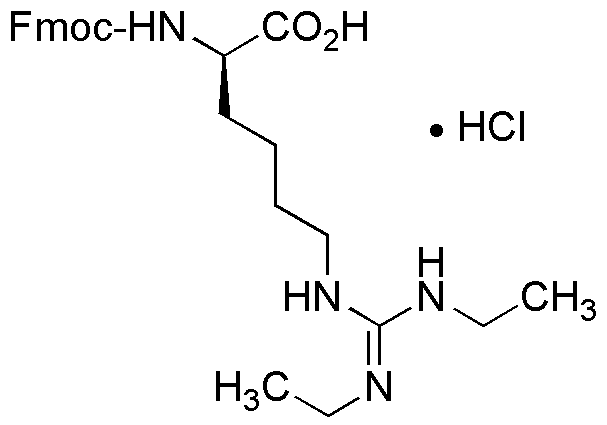Fmoc-D-Homoarg(Et)2-OH hydrochloride salt (symmetrical) is widely utilized in research focused on:
- Peptide Synthesis: This compound serves as a key building block in the synthesis of peptides, particularly in solid-phase peptide synthesis, where its protective Fmoc group allows for selective deprotection and coupling reactions.
- Drug Development: It is used in the development of peptide-based therapeutics, offering advantages in stability and bioactivity, which are crucial for creating effective drug candidates.
- Bioconjugation: The compound can be employed in bioconjugation processes, facilitating the attachment of peptides to various biomolecules, enhancing the specificity and efficacy of targeted therapies.
- Research in Neuroscience: Its structural properties make it valuable in neuroscience research, particularly in studying neuropeptides and their roles in signaling pathways.
- Custom Peptide Libraries: Researchers utilize this chemical to create diverse peptide libraries for high-throughput screening, aiding in the discovery of novel bioactive compounds.
General Information
Properties
Safety and Regulations
Applications
Fmoc-D-Homoarg(Et)2-OH hydrochloride salt (symmetrical) is widely utilized in research focused on:
- Peptide Synthesis: This compound serves as a key building block in the synthesis of peptides, particularly in solid-phase peptide synthesis, where its protective Fmoc group allows for selective deprotection and coupling reactions.
- Drug Development: It is used in the development of peptide-based therapeutics, offering advantages in stability and bioactivity, which are crucial for creating effective drug candidates.
- Bioconjugation: The compound can be employed in bioconjugation processes, facilitating the attachment of peptides to various biomolecules, enhancing the specificity and efficacy of targeted therapies.
- Research in Neuroscience: Its structural properties make it valuable in neuroscience research, particularly in studying neuropeptides and their roles in signaling pathways.
- Custom Peptide Libraries: Researchers utilize this chemical to create diverse peptide libraries for high-throughput screening, aiding in the discovery of novel bioactive compounds.
Documents
Safety Data Sheets (SDS)
The SDS provides comprehensive safety information on handling, storage, and disposal of the product.
Product Specification (PS)
The PS provides a comprehensive breakdown of the product’s properties, including chemical composition, physical state, purity, and storage requirements. It also details acceptable quality ranges and the product's intended applications.
Certificates of Analysis (COA)
Search for Certificates of Analysis (COA) by entering the products Lot Number. Lot and Batch Numbers can be found on a product’s label following the words ‘Lot’ or ‘Batch’.
*Catalog Number
*Lot Number
Certificates Of Origin (COO)
This COO confirms the country where the product was manufactured, and also details the materials and components used in it and whether it is derived from natural, synthetic, or other specific sources. This certificate may be required for customs, trade, and regulatory compliance.
*Catalog Number
*Lot Number
Safety Data Sheets (SDS)
The SDS provides comprehensive safety information on handling, storage, and disposal of the product.
DownloadProduct Specification (PS)
The PS provides a comprehensive breakdown of the product’s properties, including chemical composition, physical state, purity, and storage requirements. It also details acceptable quality ranges and the product's intended applications.
DownloadCertificates of Analysis (COA)
Search for Certificates of Analysis (COA) by entering the products Lot Number. Lot and Batch Numbers can be found on a product’s label following the words ‘Lot’ or ‘Batch’.
*Catalog Number
*Lot Number
Certificates Of Origin (COO)
This COO confirms the country where the product was manufactured, and also details the materials and components used in it and whether it is derived from natural, synthetic, or other specific sources. This certificate may be required for customs, trade, and regulatory compliance.


